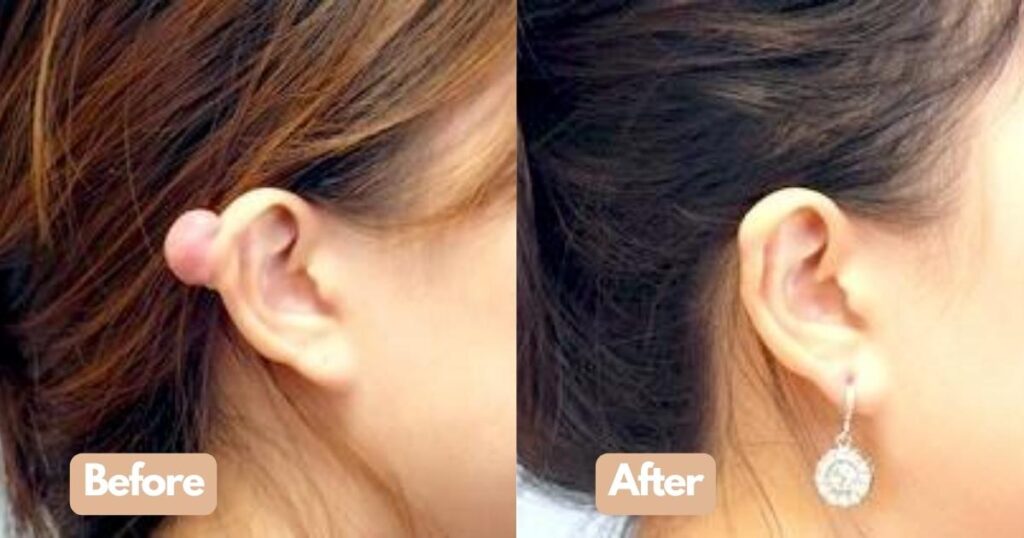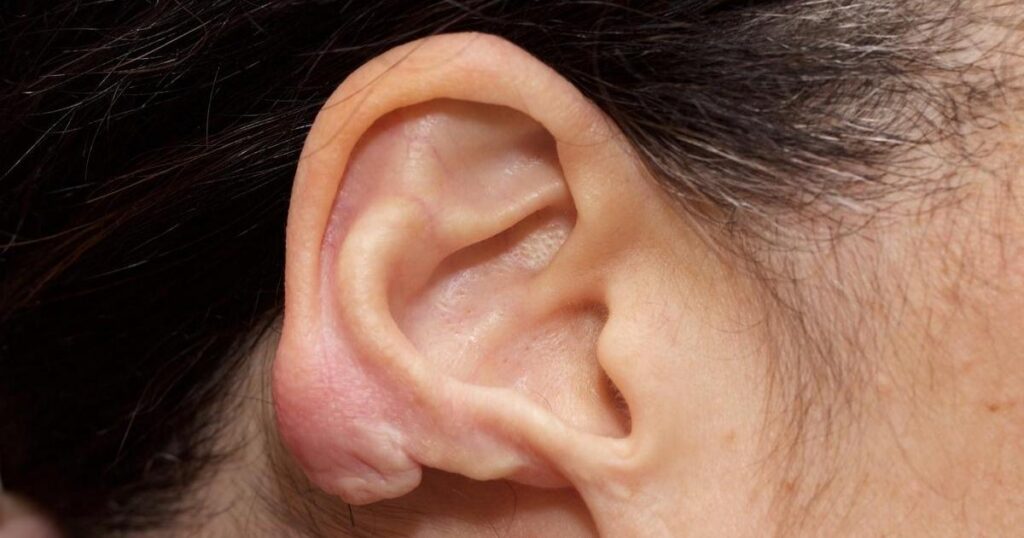Keloids are firm, raised scars beyond the original wound’s boundaries. Any part of your body can develop them, including your ears. There can be discomfort, itching, or pain associated with keloids on the ear. But worry not; keloid scar ear surgery can provide an effective solution. Her guide will give you a detailed look into this procedure, as explained by Dr Shehzadi Tasneem.
What is Keloid Scar Ear Surgery?

Keloid scar ear surgery is when doctors remove the keloid scar from the ear. It’s often done when other treatments have not worked or the scar is too large.
Dubai Keloid Care is a special clinic in dubai that helps people get rid of keloid scars. they use advanced treatments to make your skin smooth and clear again.
- Surgery Method : Doctors cut out the scar using special tools. It’s often done under local anaesthesia, which means you are awake but don’t feel pain.
- After Surgery : After removing the scar, the skin is closed with stitches. The patient may require a skin graft (taking skin from another body area).
- Recovery Time : Recovery time differs from person to person. But typically, the area takes about 1-2 weeks to heal.
Who is Affected by Ear Keloid Scar?
Ear keloids can affect a range of individuals, with certain groups having a higher susceptibility. Here’s a breakdown:
- Age Group: Ear keloids often occur in individuals between 10 and 30 but can happen at any age.
- Skin Type: People with darker skin tones are more prone to developing ear keloids.
- Piercing Enthusiasts : Those with pierced ears are at risk, as skin trauma from piercings can lead to keloid formation.
- Genetic Predisposition : Individuals with a family history of keloids are likelier to develop them.
- Gender: Both men and women are equally likely to develop ear keloids.
What causes a keloid in my ear?

Several factors can trigger a keloid in the ear: ” Cryotherapy for Scar Reduction: A Summary ” is a simple guide that explains how cold treatment can help make scars less noticeable. It’s like using ice to make a scar look smaller and lighter.
Book A Consultation With Dr Shehzadi Tasneem
Top-rated Plastic Surgeon For Keloid in Dubai
Installment Plan Available
Preventing Keloid Scars: Fast Tips for Smooth Skin is all about stopping thick, puffy scars from forming by taking quick care of your skin. It’s like a guide to keep your skin smooth and scar-free! Eradicating Aged Keloid Scars means getting rid of old, raised scars that have grown larger than the original wound. It’s like removing old, bumpy skin marks that have been there for a long time.
Removing facial keloids means getting rid of thick, raised scars on your face to make your skin look smoother. Facial keloid treatment helps to reduce or remove thick, raised scars on the face using methods like creams, injections, or surgery. Keloid scar removal Dubai fee can be different based on the clinic and treatment type it usually starts from a few hundred dollars
Nose piercing keloid treatment includes using special creams or getting small injections to make the bump go away Keloid Scar Pain Alleviation can be helped by using special creams or getting treatments from a doctor to make the pain go away.
Keloid Scar Removal: Natural Restoration helps your skin heal and look better using natural methods like oils and creams Keloid removal techniques include surgery laser treatments and steroid injections These methods help reduce or eliminate raised scars on the skin
Keloid triggers postoperative Wounds from surgery can sometimes cause keloids to form especially in people who are prone to them these raised scars may appear weeks or months after the operation Avoid keloid formation by keeping wounds clean and protected Use silicone sheets or pressure dressings to
Cost-effective keloid elimination Affordable treatments like silicone sheets or steroid injections can help remove keloids without breaking the bank Local keloid specialists are doctors who focus on treating raised scars called keloids These experts help people manage and reduce keloid scars on their skin
Keloid scar treatments can include special creams or injections to shrink the scar Doctors may also use surgery or laser therapy to remove or reduce Keloid revision techniques Doctors use special methods to make big scars smaller and less noticeable these methods are called
- Ear Piercing: The most common cause of ear keloids is ear piercing. The body’s reaction to the healing process of the piercing wound can lead to the formation of a keloid.
- Skin Trauma: The growth of keloid can be triggered by any injury to the skin, including cuts, burns, or severe acne.
- Surgical Procedures: Minor procedures on the ear, like removing a cyst or mole, can also lead to keloid formation.
- Genetic Predisposition: Some people are genetically more prone to developing keloids. Having keloids in your family may increase your risk of getting them.
- Age and Hormones: Keloids are more likely to form in people between 10 and 30. Hormonal changes during puberty may contribute to this increased risk.
How do dermatologists treat keloids?

Dermatologists offer a range of treatments to manage and reduce keloids. Treatment choice largely depends on the size, location, and number of keloids. Here are some commonly used methods:
- Corticosteroid Injections : Dermatologists inject a steroid directly into the keloid. This can help to soften and flatten the scar. Injections are usually given every four to six weeks.
- Cryotherapy : In this treatment, dermatologists freeze the keloid using liquid nitrogen. Keloid treatment can be combined with other treatments to reduce size and hardness.
- Laser Therapy: Dermatologists use a laser to flatten the keloid and make it look lighter in colour. It’s a non-invasive treatment and usually requires multiple sessions.
- Pressure or Silicone Therapy: Wearing a pressure earring or silicone sheets can help reduce the keloid’s size over time. It’s often recommended after keloid removal surgery.
- Surgical Removal: In some cases, dermatologists may recommend removing the keloid through surgery. Surgery is often coupled with other treatments to prevent keloid regrowth to prevent larger keloids from forming.
Each individual’s skin is unique, and so is each person. The dermatologist will evaluate your demands and skin condition and decide on the best course of therapy.
Keloid scar ear surgery can be a cause for concern, affecting both your physical comfort and confidence. However, with dermatology advancements, effective treatments are available to tackle these stubborn scars. Remember that consulting a professional is the first step toward successful therapy.
Keloids shouldn’t prevent you from living your best life. Take control of your skin health today. If you’re considering keloid scar treatment, book a free consultation with Dr Shehzadi Tasneem can set you on the right path.












